



How many pictures does Virginia Roberts have to show to ‘prove’ her version of events?
How many victims does it take to bring down a modern day Goliath?
Who else went to Little Saint James?
Why did Epstein and his associate die in their prison cells?
Why do power and status enable sexual assault?
Questions & complaints that will forever be unanswered and unheard.
https://www.defiance.news/ghislaine-maxwell
This 7 part podcast about Ghislaine Maxwell, her relationships with Jeffrey Epstein & Prince Andrew, is a heart-breaking eye opener on the injustices of our world, on the abuse of power and the absurdity of our judiciary systems.


Truth is a tool that one shapes, twists and bends into their own favour.
Truth is an arm-wrestling battle between two or more versions of events. May the (most powerful) best (hu)man win!
Since truth is a social construct, who are you more likely to believe?
A well-established public figure with millions of admirers or an unknown commoner who claims to be a victim.

On the 14th of December 2008, during a press conference in Iraq, United States President George W. Bush dodges a pair of shoes journalist Muntadhar al-Zaidi threw at him.
When all a journalist is left to fight with are his shoes, & when words lose their meaning, you know that there is no truth.
Complaints on the soles of our shoes.
I wish the dirty soles of Muntadhar’s shoes violently hit Bush’s rosy cheeks.
I wish he didn’t duck under that stupid wooden podium.
I wish his post-attack smirk was replaced by a cry of pain and tears of agony.
I wish he could feel one millionth of the hurt and loss he has caused.
I do not believe in hell but I wish he would rot in it.
PS: I hate his paintings.



This Illustration is inspired by Chapter 4: „Misfitting And Complaint“, a chapter in which the Ahmed explores the idea of institutions being buildings built around bodies. “A misfit occurs when the environment does not sustain the shape and function of the body that enters it.” (Rosemarie Garland-Thomson, 2014, n.p.) In other words: Institutions are built to accommodate specific bodies/people. For some people in order to fit in they need to change the structure of a building.
1 The Queering of Time
On paper, a formal complaint appears as a straight line, pointing the complainer in the direction they need to go, the „path of complaint as laid out by the institution“ (p. 265). Procedures created by the institution itself tell you when and where you have to be, to submit forms or give testimonies. The process of complaint is not linear. There is no definite starting point nor an end. It starts long before reaching the point of even expressing a complaint, at some point in the past. Maybe it starts with a vague feeling that something isn‘t right or with the questioning of your own perception until you slowly realize what is actually happening. In order to understand what is happening in the present, you have to reflect your past experience.
Ahmed describes complaint as immanent. Complaints „are about what precedes them, even if it‘s ongoing“ (Complaint as Feminist Pedagogy, 2021). To reach the point of complaint, you have to go back in time: „immanence as presence or even the present, but it can also imply what remains, immanence as what carries on from the past, what has not been transcended or what we are not over“(p. 101). To go back over your experience, telling your story over and over again, „looping and folding, zigging and zagging“ (Erin Grogan, 2020) in time. The process of Complaint has a queer temporality because „Going back can mean going all over the place.“ (p. 101).
The end of a formal complaint is not the end of a complaint. A complaint becomes a file. Even if it is filed away in a cabinet, it becomes part of the institution. A body can also be a file cabinet holding „what remains“, „what we are not over with“ (Complaint as Feminist Pedagogy, 2021). Even though your complaint does not visibly transform the institutions, it is still going somewhere. It becomes data we leave behind, testimonies of what is happening to us, what is happening in the institution. It becomes a record, like the complaints which came before ours and those which will come after. To leave our record behind is „to leave trails behind us so that others can find us.“ (Complaint as Feminist Pedagogy, 2021). A complaint becomes part of the institutions‘ history. It becomes part of a complaint history. Making a complaint means digging up past complaints. „After all, as we have learned, a complaint in the present can lead to an unburial of past complaints.“ (Complaint as Feminist Pedagogy, 2021). Complaints open „the door to what came before“ (p. 303). A door becomes a portal through time. „Complaints in pointing back can also point forward, to those who come after“ (p. 300). Complaint is a legacy we inherit. We inherit the work of past complainers. The impact of our complaints is not yet tangible in the present. „Impact is a slow inheritance“ (p. 310). With each generation of complaint piling up, digging up, we weaken the structure of the institution.
Complaints are messy. They linger hidden in file cabinets and institutional closets to remind us of what happened and what is still happening. Complaint can offer a transgenerational intimacy, to go back, to go over, as to go toward.“ (p. 295). In order to transform the future, we need to challenge the present. In order to challenge the present, we need to learn from the past.
2 The Queering of Space
Complaints contained in file cabinets and bodies, in the same spaces in which they were formed. Institutions are build around bodies. There are those bodies which the structure is shaped around them and there are those who don‘t fit in. Ahmed draws an example of a post-box. The small slit of a post-box is constructed for letters to get in. A sign: „birds welcome!“, does not change the fact that the space was intended for a different body, a different purpose. The space was never intended for birds, only for letters. The body of a bird will not fit. „A misfit occurs when the environment does not sustain the shape and function of the body that enters it.” (Rosemarie Garland-Thomson, 2014, n.p.). Like a bird, we can not get into a house that was not build for us. Institutions are houses build around specific bodies and to enable specific bodies. Institutional houses often are already occupied by those bodies.
We learn how spaces are occupied when we learn by whom they are occupied and by whom not. As a disabled person, for example, you learn how spaces are occupied when the room you need to be in is not accessible for your type of body. In this case, the structure is build around an able-bodied person. Ableism is part a structure.
This „incongruous relation of your body to thing or body to world“ (p. 140) makes you work harder than others to fit in. Birds can work to turn the post-box into a nest, turning the slit into a door, „a queer door perhaps“ (p. 137), but not without transforming the whole purpose of a structure. To accommodate the bird‘s nest we need to stop the letters coming in, we have to stop „what usually happens in that room.“ (Complaint as Feminist Pedagogy, 2021). Structures reproduce the same structures if we do not interrupt them, which means transforming a space in ways it was not intended for, open it up for bodies for whom it was not intended for, therefore „queering a space“. Complaint can mean queering a space. (What’s the Use?, 2019)
Complaint teaches us how houses are build. For some bodies to get into a house „often requires a world-dismantling effort.“ (p. 137). This can mean dismantling structures to open up the space for more people or even „bringing the house down“. Both, dismantling and modifying spaces can be threatening for the ones already occupying that space. For others, it might be necessary to get in.
3 Conclusion
Complaints are messy. They are „looping and folding, zigging and zagging“ all over the place. They affect those who they come in contact with, involving people at different times and in different places. Complaints are what we leave behind. They become part of the history of the institution, and they become part of its future. Even if they end up hidden in file cabinets, in the „shadowy corners of the institution“ (p. 276), we learn how institution are inhabited. Often, complaining means „inhabiting the institution all the more.“ (p. 276).
References
Ahmed, S. (2021). Complaint! (1. Aufl.). Duke University Press.
Ahmed, S. (2021b, Juni 16). Complaint as Feminist Pedagogy, 06.12.2021 on https://feministkilljoys.com/2021/06/16/complaint-as-feminist-pedagogy/
„Correction is often heard as complaint: as being negative,assertive, demanding.“ (Ahmed, p. 119)
This quote by Sara Ahmed stuck with me while reading the book, trying to understand the many ways in which complaint works. We learn how complaint is communicative labor because you have to express what your complaint is about, you have to tell your story, making the same points and sharing them with others over and over again: „you have to keep coming out; you have to come out as somebody this happened to, to come out as somebody who is complaining that this happened.“ (p 119). You have to come out as a complainer.
Coming out as a queer person means always correcting peoples presumptions because of how „the world presumes a certain kind of body“ (gender, sex, sexuality etc). Western society presumes only two opposite categories of sex and gender exist. As a non binary person, I therefore do not fit those presumptions and always have to correct them, correcting people using the wrong pronouns or how they adress me, for example. „Correction is often heard as complaint“, as „moaning“ or maybe of just being different, sticking out. (Ahmed, p 119)
Every time, before I correct in those situations, before even expressing my „complaint“, I go through an inner process of questioning myself and contemplating, if I should even correct the person I am talking to or if I should just led it slide. Correcting them means coming out to them, and this means „to reveal something“ (p 119). „When you complain, your own body is turned into testimony, as revealing something about yourself“ (p 144). That something is a sensitive matter, my personal story, the testimony of my trans body. Through complaint, I open myself up to sensitive, often intrusive questions. I read somewhere, that cisgender people, when meeting a trans person, lose their feeling of empathy, of what is okay to ask and what not. That is my experience too. It is quite perplexing what conversations I had with complete strangers, after I unintentionally came out to them, just by correcting them about my pronouns.
Also, in chapter four, Becoming/Unbecoming a complainer, Ahmed talks about how the person complaining becomes the problem: „…as soon as you draw attention to structures you draw attention to yourself, the structures do not come in view; you do.” (P148). When correcting someone about my pronouns, I become the problem, not the constructions society build around gender norms. I am heard as being different, not assimilating to societal norms, I am the one standing out, therefore I become the target of complaint. Complaint, in this case, meaning trans- and homophobia.
Correction is often heard as complaining, therefore as something negative and demanding. I am „demanding“ them to go out of their way to use the correct pronouns, causing them an inconvienience, becoming an inconvenience.I do not want to be an inconvenience, a tiresome complainer who is always correcting. But I have to, because if I want to be seen, I have to complain.
References
Ahmed, S. (2021). Complaint! (1. Aufl.). Duke University Press.
Ahmed, S. (2021b, Juni 16). Complaint as Feminist Pedagogy, 06.12.2021 on https://feministkilljoys.com/2021/06/16/complaint-as-feminist-pedagogy/
From complaint, we learn how institutions work and how power structures are formed by reproduction of patterns. Injustice and violence can be patterns. Complaint can be seen as a necessary tool to stop this reproduction. Even if the complaints are dropped or filed away, they still become part not only of the institutions‘ history, but also of the complainers‘ history. The knowledge we take away from the effort of making a complaint becomes our „institutional wisdom“ (Ahmed, 2021). In a blog entry, Ahmed talks about Complaint as a „Feminist Pedagogy“ or „the pedagogy of the oppressed“ (p. 115) and what complaint teaches us about institutions.
„Complaint as feminist pedagogy: to make a complaint within an institution is to learn about how institutions work, what I call institutional mechanics.“ (Complaint as Feminist Pedagogy, 2021)
In chapter one, Mind the gap, she writes about how an institution tells its story is quite different from the story, a complainer tells about the same institution. Ahmed describes it as the gap between what an institution appears to be on the outside and how it actually is experienced. The label of diversity, which many institutions use to present themselves, is more often than not just a word without an action. Written policies that fail to „bring into effect what they name.” (p. 30) are a gap between what is supposed to happen and what is not happening.
In order to get a formal complaint through the system, you need to learn how the system works, you become part of the system. „Policies provide a set of principles and values that are supposed to govern institutions.” (p. 29). They will tell you what to do and point in the direction you need to go, they give you a path. This path can appear lineal, but it is in no way an easy one.
“Complaint as feminist pedagogy: the system is working by stopping those who are trying to stop the system from working.“ (Complaint as Feminist Pedagogy, 2021)
Institutional mechanics are designed to make it hard for complainers to even get a formal complaint through, or in other words, are „designed to make it difficult for people to proceed with a complaint.”(p. 78). They are used as tools to stop complaint. Procedures require you to submit certain forms at certain times, to be at certain places and who to talk to. In Strategic Inefficiency, Ahmed describes how the same system, which is supposed to guide complainers to get their complaint through, does the opposite, by wasting their time and resourcess and tiring them out. Slow processes, strict guidelines, administrative failure, constant change of procedures lead to dismissed complaints on procedural grounds. „Power works by making it hard to challenge how power works.” (p. 125)
We learn how institutions work by learning how complaints are stopped. A complaint which is a tool to stop the reproduction of the same oppressive system, is simply nothing more than the flow of information, that is stopped by inefficiency. It becomes clear who those procedures work for when a student can not meet the deadline to submit a form because of chronic illness. Inequality gets reproduced.
“Complaint as feminist pedagogy: what you are told you need to do to progress further and faster in the system is what reproduces the system.“ (Complaint as Feminist Pedagogy, 2021)
The structures of a system is about what is reproduced. When you become part of an institution, you are expected to reproduce the structure by agreeing and proceeding in the same cycle of injustice and violence. When you are not „willing to participate“ in this system, the violence gets redirected towards you. „Violence is redirected toward those who identify violence“. To challenge the system, we first need to learn how to survive it. Ahmed writes in her book, how she and others interviewed by her, expressed their complaints in different ways and places to not become a target. For Ahmed herself this meant leaving the institution, withdrawing herself and her work and collecting the stories of other complainers. This collection of stories and experiences become resources to other complainers.
Even if our complaints may not seem tangible, what we take away from that effort is what Ahmed calls „institutional wisdom“. That knowledge about institutional structures helps us in challenging and transforming the same structures that oppress us.
References
Ahmed, S. (2021). Complaint! (1. Aufl.). Duke University Press.
Ahmed, S. (2021b, Juni 16). Complaint as Feminist Pedagogy. feministkilljoys. Abgerufen am 06. Dezember, 2021, von https://feministkilljoys.com/2021/06/16/complaint-as-feminist-pedagogy/
In May 2012 the first New World Summit took place in the Sophiensaele theater in Berlin. Wooden Constructions hanged with colorful flags framed the circular space which became the stage of many different international political organizations, invited by Artist and founder Jonas Staal. All of those, are autonomous groups, currently listed on the so-called ‚international terrorist lists‘. One of them was Fadile Yildrim, a representative of the Kurdish women movement, an organization, founded on the principles of gender-equality, communal economy and self-governance. Speakers like Yildrim, fighting for a stateless and fundamental democracy, inspired Staal to continue the New World Summit, with the goal, to host every organization currently banned by the ‚Terrorist Lists‘. (Staal, 2012)
In Complaint!, Ahmed collects interviews and testomonies of people, challenging the power structures that institutions are reproducing. Similar to the book, the New World Summit becomes a complaint collective, where the stories of those who where silenced, are told. Through performance art, Staal forms an alternative parliament, where activists, diplomats and artists, otherwise excluded from democratic discourses, could present their work to an audience.
As an visual artist, Staal explores the relations between art, propaganda and democracy. He believes democracy to be limitless, at least in definition. In reality, secret committees like the Clearing House operate in secret, and have the power to single-handedly dismiss political groups as terroristic. Outside the public eye, they decide who gets the right to speak, to participate and who not. An inherently undemocratic practice, which is influenced by diplomatic prejudices and personal gain of nations and governments. But what if the political models, of blacklisted groups „are more democratic than capitalist-democracy itself?“ (Staal, 2019) In that case, Staal argues, „their threat is primarily ideological.“ (Staal, 2019) This ideology of the capitalist-democracy is described by him as „democratism“, a democracy that is stagnant and „ideological of administration and governance“ (Staal, 2013, P. 73). It is a democracy where organizations, fighting for liberation and equality, like the Kurdish women movement, can be silenced by one committee to keep up their status quo. But if we think of the Clearing House comittee as merely a tool for reproducing power structures, the state/nation is the one who builds those power structures. „Power works by making it hard to challenge how power works.” (Ahmed 2021, P 125), Ahmed writes in her book. In her sense, political organizations, like the ones mentioned are, in the eyes of democratism, complainers. By challenging the power structure build by the state, they become the problem, not the structure they were complaining about. Institutions like the Clearing House are silencing complainers by cutting them off from public discourse and from their access to resources. “Power is not simply what complaints are about; power shapes what happens when you complain.” (Ahmed, 2021, P 24) Challenging power structures by not participating in the reproduction of the violence and harassment of that structure, that violence gets redirected towards oneself. ”If escalation can be another method of stopping a complaint, escalation includes not only the increase of force but the denial of force.” (Ahmed, 2021, P 135). The violence directed towards the complainer takes place behind „institutional blinds“ (Ahmed, 2021), away from the public eye, or is justified by declaring the complainer as a thread to democracy. Either way, the complaint is contained or shut outfrom the institution, to protects itself, its reputation and of course, its status quo. Democratism creates it‘s own narrative about a democratic and positive environment, by dividing people into „us“ versus „them“, turning „them“ into threads to the system. The New World Summit aims to „redefine who exactly is “Us” and who is “Them” (Staal, 2019). Staal puts together those alternative parliaments of organizations labeled terrorists, to „structurally oppose a series of monopolies“ that he describes as „the pillars of democratist politics.“ ( Staal, 2013, P 76)In the chapter „Mind The Gap!“ (Complaint, 2021), Ahmed talks about the gap between what the institution appears to be and what the actual experience inside the institution really is. Looking closely, democratism acts against the core principles of democracy, which it is stating to protect, by controlling what information is publicly available and which not, therefore controlling the flow of information. Ahmed also writes about control of the flow of information“ as an „effort to stop a complaint“. (Ahmed, 2021, P 98) Art is a medium to transport information and can therefore be used as a political tool by the institution itself, but also, against it. By using art‘s relative autonomous position in politics and society, the New World Summit brings back the information, hidden and contained by democratism, back into the public eye. Staal opens up spaces for political speakers, in an effort to answer the question. „how, from the perspective of an artist’s practice, to use the discursive space opened by Institutional Critique“. (Staal, 2013, P 76)Art is how we can express complaint, even bypassing existing anti-terrorist laws:
„I propose a pedagogy of fundamental democracy as its counterpoint, aimed at teaching how to liberate democracy from the state, The revolutionary tool called „art“ will be the weapon to bring this pedagogy into practice and fight the representatives of democratism passionatly.“ (Art After Democratism, 2013, P 254)

References
Ahmed, S. (2021). Complaint! (1. Aufl.). Duke University Press.
Staal, J. (2012). New World Summit-Berlin. Jonas Staal. Abgerufen am 3. Januar 2022, von http://www.jonasstaal.nl/projects/new-world-summit-berlin/
Staal, J. (2013). Art After Democratism: The Pedagogy Of The New World Summit. In Pedagogies Of Disaster (S. 247–255). Department of Eagles.
In her work, Kit reminds me of the form in the book. ‘Form’ is usually the first object that a complainer encounters. And sometimes it’s the last chance to explain what happened to the complainant. Eventually, at the end of this process, the paper will become a “separated body” and a separate voice, just like the kit in the work of Eliza Schvartz. How is this form being written, which has already been handed over to the institution and is part of an indelible complainer? Can this form properly capture me and my complaints?
Mainly in form, blank spaces had to be filled in an orderly way. which is compulsory. There is no space for ambiguity. After the form was filled out, every case looked flawless and clear. Becoming flawless and simple means that the case is separated from the complainer’s body and voice. Every word from the complaint is separated from the complaint itself.
Let’s go back to the cord, now the meaning of cord could be expanded to form. If you look at the whole process of complaining as a process of weaving a cord, the form should be an important document that distinguishes my cord from others. It should be the only piece of paper that describes my cord.
The ‘form’ could be the life-ring at the end of the cord. When we throw the life ring, it should be the one we can trust and grab. If we already know the end of the form could be the cabinet, then at least we need something more than a case number and boring documentation. At some point, I started to question why we cannot make a more relevant or striking form. The form should not be intended to define clear normative principles. Rather should have the intention of finding ambiguity and contradiction in each case.
So I want to build a form that would allow for ambiguity. For amplifying the complaint, I feel the necessity to re-design the form. Making a form for the complaint could be challenging since every case has different shapes and voices. Maybe the idea of “form” which already has a meaning of “uniform” would not be a perfect way of “hearing” the voice. However, if we agree with the necessity of compiling the complaint’s narrative as a testimony and being a catalyst from hereafter, and not only as a piece of evidence but also as a “discrete body”, I reckon we all agree to the making better form.